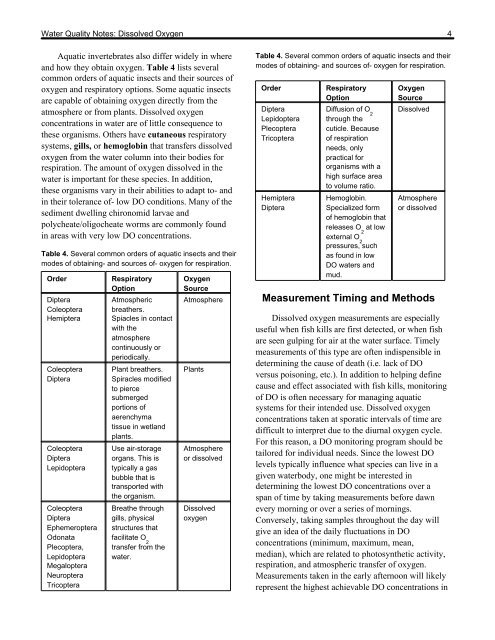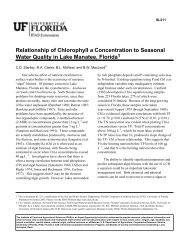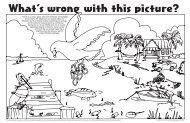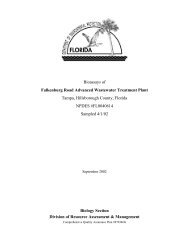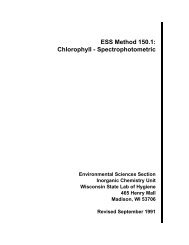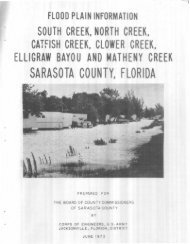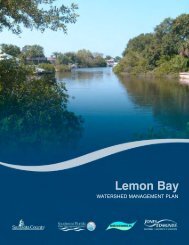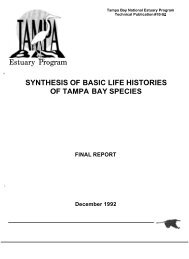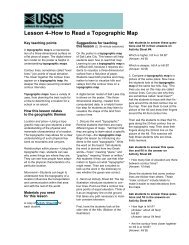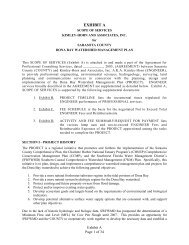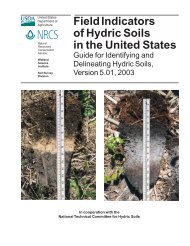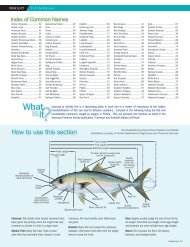Water Quality Notes: Dissolved Oxygen1 - Polk.WaterAtlas.org
Water Quality Notes: Dissolved Oxygen1 - Polk.WaterAtlas.org
Water Quality Notes: Dissolved Oxygen1 - Polk.WaterAtlas.org
You also want an ePaper? Increase the reach of your titles
YUMPU automatically turns print PDFs into web optimized ePapers that Google loves.
<strong>Water</strong> <strong>Quality</strong> <strong>Notes</strong>: <strong>Dissolved</strong> Oxygen 4Aquatic invertebrates also differ widely in whereand how they obtain oxygen. Table 4 lists severalcommon orders of aquatic insects and their sources ofoxygen and respiratory options. Some aquatic insectsare capable of obtaining oxygen directly from theatmosphere or from plants. <strong>Dissolved</strong> oxygenconcentrations in water are of little consequence tothese <strong>org</strong>anisms. Others have cutaneous respiratorysystems, gills, or hemoglobin that transfers dissolvedoxygen from the water column into their bodies forrespiration. The amount of oxygen dissolved in thewater is important for these species. In addition,these <strong>org</strong>anisms vary in their abilities to adapt to- andin their tolerance of- low DO conditions. Many of thesediment dwelling chironomid larvae andpolycheate/oligocheate worms are commonly foundin areas with very low DO concentrations.Table 4. Several common orders of aquatic insects and theirmodes of obtaining- and sources of- oxygen for respiration.OrderDipteraColeopteraHemipteraColeopteraDipteraColeopteraDipteraLepidopteraColeopteraDipteraEphemeropteraOdonataPlecoptera,LepidopteraMegalopteraNeuropteraTricopteraRespiratoryOptionAtmosphericbreathers.Spiacles in contactwith theatmospherecontinuously orperiodically.Plant breathers.Spiracles modifiedto piercesubmergedportions ofaerenchymatissue in wetlandplants.Use air-storage<strong>org</strong>ans. This istypically a gasbubble that istransported withthe <strong>org</strong>anism.Breathe throughgills, physicalstructures thatfacilitate O2transfer from thewater.OxygenSourceAtmospherePlantsAtmosphereor dissolved<strong>Dissolved</strong>oxygenTable 4. Several common orders of aquatic insects and theirmodes of obtaining- and sources of- oxygen for respiration.OrderDipteraLepidopteraPlecopteraTricopteraHemipteraDipteraRespiratoryOptionDiffusion of O2through thecuticle. Becauseof respirationneeds, onlypractical for<strong>org</strong>anisms with ahigh surface areato volume ratio.Hemoglobin.Specialized formof hemoglobin thatreleases O2at lowexternal O2pressures, suchas found in lowDO waters andmud.OxygenSource<strong>Dissolved</strong>Atmosphereor dissolvedMeasurement Timing and Methods<strong>Dissolved</strong> oxygen measurements are especiallyuseful when fish kills are first detected, or when fishare seen gulping for air at the water surface. Timelymeasurements of this type are often indispensible indetermining the cause of death (i.e. lack of DOversus poisoning, etc.). In addition to helping definecause and effect associated with fish kills, monitoringof DO is often necessary for managing aquaticsystems for their intended use. <strong>Dissolved</strong> oxygenconcentrations taken at sporatic intervals of time aredifficult to interpret due to the diurnal oxygen cycle.For this reason, a DO monitoring program should betailored for individual needs. Since the lowest DOlevels typically influence what species can live in agiven waterbody, one might be interested indetermining the lowest DO concentrations over aspan of time by taking measurements before dawnevery morning or over a series of mornings.Conversely, taking samples throughout the day willgive an idea of the daily fluctuations in DOconcentrations (minimum, maximum, mean,median), which are related to photosynthetic activity,respiration, and atmospheric transfer of oxygen.Measurements taken in the early afternoon will likelyrepresent the highest achievable DO concentrations in


